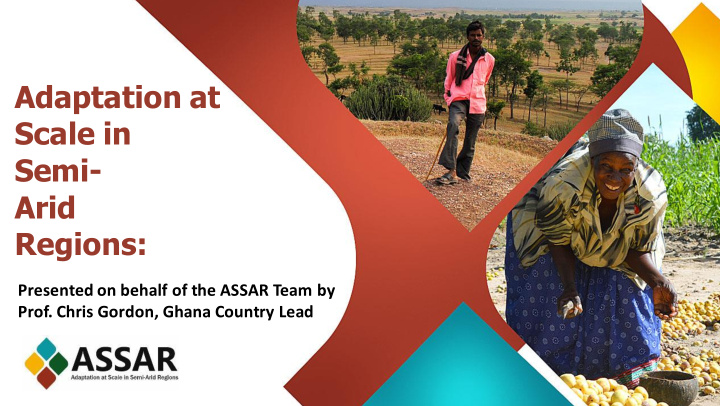



Adaptation at Scale in Semi- Arid Regions: Presented on behalf of the ASSAR Team by Prof. Chris Gordon, Ghana Country Lead
Adapt to climate change India and climate Mali variability Ghana Ethiopia Kenya Botswana Namibia Semi-arid areas Improve the lives of the most marginalised.
Many levels of governance India Mali Ghana Ethiopia Social diversity Kenya Botswana Namibia Improve the lives of the most marginalised.
WEST AFRICA INDIA India Mali Ghana Ethiopia Kenya SOUTHERN AFRICA EAST AFRICA Botswana Namibia Project Management Unit
High-level Migration/ Cross-regional Mobility synthesis Transformative Barriers and scenario enablers planning Shifting the Ecosystems adaptation + Land change narrative Approaches and Outputs Effective Governance adaptation Research / Knowledge practice Systems interface Social Research Transformation Differences Wellbeing Streams
CROSS REGIONAL CASE STUDIES MOBILITY/MIGRATION IN SEMI-ARID REGIONS USING MENTAL MODELING METHODOLOGY
METHODS 6 life course interviews per country Quantitative household data Open unstructured Household head plus household member of different gender Mix of locations, cultures, religions, livelihoods, mobility, urban/rural Cases Not representative but illustrative Insights into drivers, compound shocks, choice, intra-household dynamics, wellbeing, aspirations
Accelerators of mobi bility Job opportunities Drought ! Debt Death of household head Conflict Falsely accused of murder Conflict between families
Bra rakes es to to mobility ty Community Access to land and housing Church provides school fees and food Support of Muslim community Recognition in the Established business community Hard to get new land Obligation Conflict Work mother’s farm Insecurity reduce access to livestock Muslim wife market Run aunt’s business Traditional & no education Work farm and look after grandma Fear of the unknown
IMPLICATIONS FOR ADAPTATION Moving out: reduced exposure to uncertainty from farm livelihoods BUT signals a narrowing of livelihood opportunities when we make agricultural systems unviable Moving in: increased exposure to non-climatic risks and potential narrowing of adaptation option space as they move into cities Adaptation is a behavioural change (towards more flexible, forward-looking decision-making); not seeing the same in migration process Broader implications of development pathways, trade-offs, thresholds
IMPLICATIONS FOR SDGs Everything SDG1: No Poverty is linked to • Rights to economic resources, control of property, Water inheritance, microfinance SDG4: Quality education • Complete free education, increase skills for employment SDG5: Gender equality • Equal opportunities SDG8: Decent work and economic growth • Full, productive, decent, safe work SDG11: Sustainable cities and Communities • Access to housing and services SDG13: Climate action • Increase adaptive capacity
Way Forward: Research into Use Research and Evidence Needs to help Policy makers and Communities: Which Critical investments into agriculture should be prioritized to support farming all year around? What Enterprise training and funding programmes should be promoted as alternative livelihood sources? How to support communities (religious/social etc.) serving as safety nets for vulnerable people? Who should be targeted to close the resource gap between urban and rural centers to reduce the rural- urban migration? Is it possible to address the challenges of rural urban drift by implementation of integrated Adaptation and SDGs policies.?
Thank you! Supported by: Project Website: www.assar.uct.za Institute for Environment and Sanitation Studies Website: http://iess.ug.edu.gh/
Recommend
More recommend